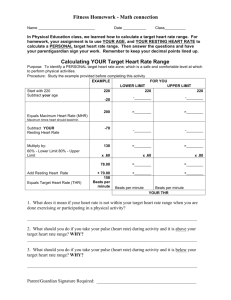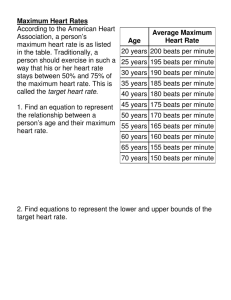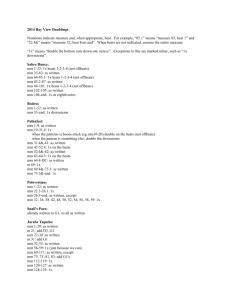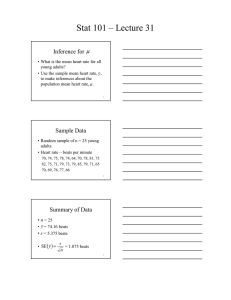Interpreting the outcome of Single Sample T-test
advertisement
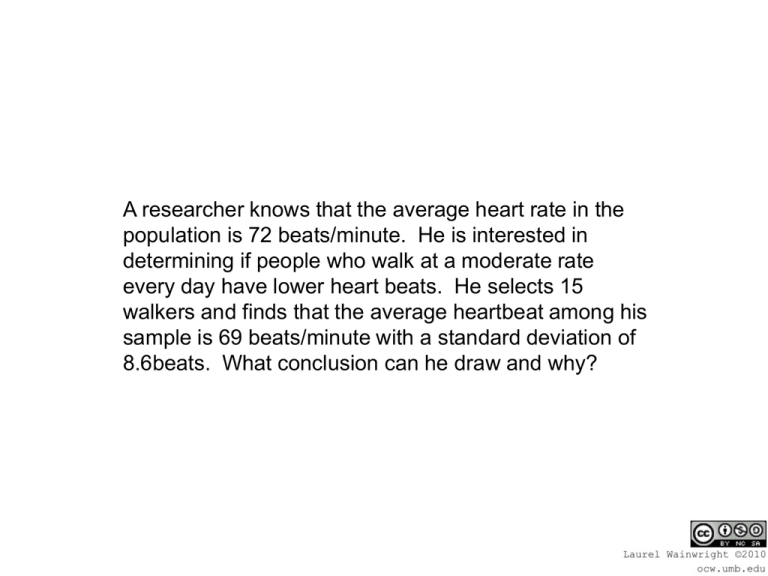
A researcher knows that the average heart rate in the population is 72 beats/minute. He is interested in determining if people who walk at a moderate rate every day have lower heart beats. He selects 15 walkers and finds that the average heartbeat among his sample is 69 beats/minute with a standard deviation of 8.6beats. What conclusion can he draw and why? A researcher knows that the average heart rate in the population is 72 beats/minute. He is interested in determining if people who walk at a moderate rate every day have lower heart beats. He selects 15 walkers and finds that the average heartbeat among his sample is 69 beats/minute with a standard deviation of 8.6 beats. What conclusion can he draw and why? 1) Determine what you know: 72 X 69 s 8.6 A researcher knows that the average heart rate in the population is 72 beats/minute. He is interested in determining if people who walk at a moderate rate every day have lower heart beats. He selects 15 walkers and finds that the average heartbeat among his sample is 69 beats/minute with a standard deviation of 8.6 beats. What conclusion can he draw and why? 2) Choose formula: No standard deviation of the population This means a t test for single sample. A researcher knows that the average heart rate in the population is 72 beats/minute. He is interested in determining if people who walk at a moderate rate every day have lower heart beats. He selects 15 walkers and finds that the average heartbeat among his sample is 69 beats/minute with a standard deviation of 8.6 beats. What conclusion can he draw and why? 3) Write hypothesis statements H 0 : 72 H1 : 72 A researcher knows that the average heart rate in the population is 72 beats/minute. He is interested in determining if people who walk at a moderate rate every day have lower heart beats. He selects 15 walkers and finds that the average heartbeat among his sample is 69 beats/minute with a standard deviation of 8.6 beats. What conclusion can he draw and why? 4) Compute t value a) Compute standard error estimated S SX n S SX n SX 8.6 15 8 .6 SX 3.87 S X 2.22 X t SX 69 72 t 2.22 3 t 2.22 t 1.35 H 0 : 72 H1 : 72 df = 14 critical value = 2.145 Conclusion: Accept the null hypothesis. This sample is not significantly different from the whole population. This means: That moderate walking was not shown to have an effect. Another researcher is interested in a similar question. She asks whether people who do aerobic exercise at least three times per week have lower heart beats. She selects 15 exercisers and finds that the average heartbeat among this sample is 67 beats/minute with a standard deviation of 8.6 beats. What conclusion can she draw and why? Another researcher is interested in a similar question. She asks whether people who do aerobic exercise at least three times per week have lower heart beats. She selects 15 exercisers and finds that the average heartbeat among this sample is 67 beats/minute with a standard deviation of 8.6 beats. What conclusion can she draw and why? X 67 All other values remain the same. X t SX 67 72 t 2.22 5 t 2.22 t 2.24 H 0 : 72 H1 : 72 df = 14 critical value = 2.145 Conclusion: Reject the null hypothesis. This sample is significantly different from the whole population. This means: That aerobic exercise appears to have an effect of lowering heart rate.

